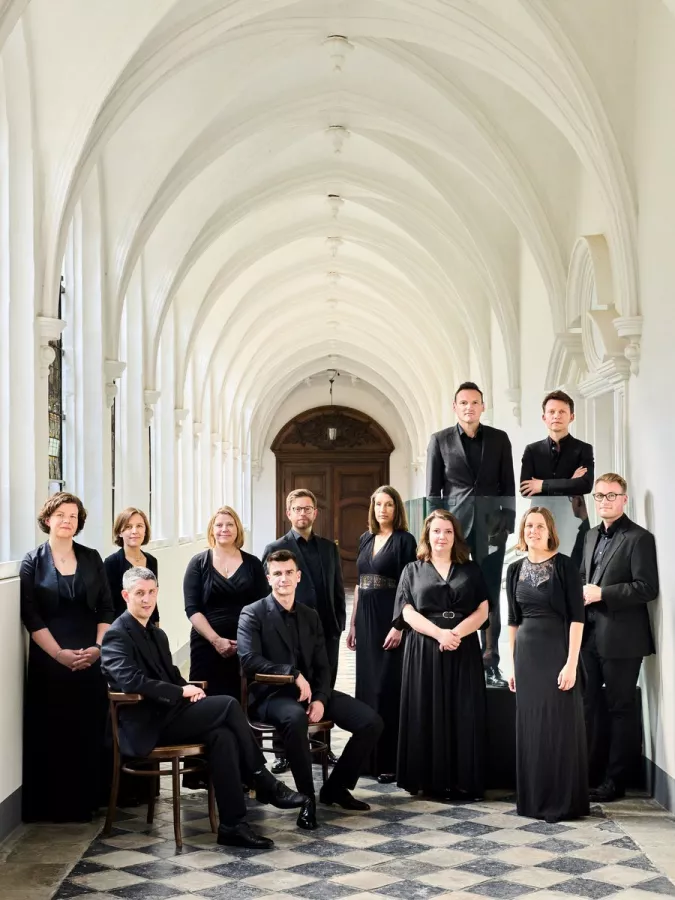Stile Antico Perform the Works of William Byrd at Swarthmore College

Stile Antico
One of the world’s best Renaissance vocal ensembles, Stile Antico, will perform and hold a masterclass at Swarthmore on Sunday, October 1st in Lang Concert Hall.
Stile Antico focuses on Renaissance polyphony: European music from the 15th to 17th centuries where two or more independent melodies are sung simultaneously. According to Swarthmore Music Professor James Blasina, the goal in composing polyphony is to combine melodic lines that are as different from one another as possible – while still sounding good together – by employing a technique known as counterpoint.
The 12 members of Stile Antico perform without a conductor, listening and responding to each others’ voices during rehearsals and performances. According to Prof. Blasina, this requires subtle skills and a high level of musical collaboration.
“They're really sensitive in their performances,” Blasina said. “The level of acuity and precision that they are able to achieve without having a conductor standing in front of them is a little bit mind-blowing.”
At Swarthmore – and as part of a larger international tour – Stile Antico will be performing the work of English composer William Byrd, to mark the 400th anniversary of his death. Byrd, employed by Queen Elizabeth I of England in her Chapel Royal, was involved in seditious covert Catholicism. It was illegal to practice Catholicism in England during this time period, but through music, he found a path to religious expression while staying in the good graces of the Queen. The Queen appreciated his music so much that she personally intervened to prevent his criminal prosecution.
“It's a fascinating example of how music can be made in a climate of persecution, and how a particular political context actually shaped the music that was performed,” Blasina said. “For example, William Byrd’s Mass for Four Voices: It was written for four voices because singing the Catholic mass was illegal, and so it meant if there were only four people present, they could [perform] it in private."
Stile Antico’s performance is in conjunction with a new seminar offered this semester: Sound, Salvation, and Statecraft in Tudor England with Professor Blasina. The course covers the way that music was implicated in the political, religious, and social changes in England from 1485 to 1603. Ever-changing religious and political demands were put on composers of the era, who employed various strategies to respond musically, stay safe, and live according to their consciences.
Blasina contends that Byrd’s composition demonstrates a high attention to text setting and emotional content. In some cases, his creativity resulted in extraordinary musical features for his era. Some of Byrd’s techniques such as specific syncopations – disturbances in the flow of rhythm – are rare for his time, and would not be heard again in Western music until the 19th century. Additionally, despite the years, the conversations circulating four centuries ago around the value of music persist.
“Byrd lived in a turbulent period of history when the social role of music and the arts was being questioned . . . . Our context is different, but we are seeing questions being asked [today] about the value of the arts, often through funding decisions in schools and colleges and society at large,” Blasina said. “Byrd wrote about the benefits of singing to mental and physical wellness, the contributions of music to broad education and the public good, and the inclusivity of music. These are all values that we promote in the Music program, and that we believe are just as relevant today as in the sixteenth century.”
Blasina sees the historical background of Byrd reflected in Stile Antico’s performances. By offering context on pieces throughout their shows, Blasina believes Stile Antico tells a story with their performances, integrating music scholarship and practice.
“We’ve become so comfortable with the idea of hearing music in a concert hall that it’s easy to lose sight of the fact that lots of that music was composed for other social functions. As wonderful as concerts are, what is lost when we move music into the concert hall, and what can we do in performance to try to regain that? Through their use of space and personable explanations, Stile Antico goes beyond the musical sounds to reinforce musical meaning for audiences.”
Stile Antico’s visit is part of a department-wide effort, led by both faculty and students, to constantly expand the music taught at Swarthmore and link scholarship and performance through examples and visits. Choral students will get to perform and interact with Stile Antico at the masterclass, and Blasina thinks this type of experience is equal to that of multiple regular rehearsals. This is especially true for Swarthmore’s Garnet Singers, and the Fetter ensemble Critical Mass, who perform a similar style of polyphony. Blasina and Swarthmore Music are thrilled to be hosting Stile Antico on Sunday, October 1st in the Lang Concert Hall for their performance at 3 p.m. and their masterclass at 6:30 p.m. Both engagements are free and open to the public.



